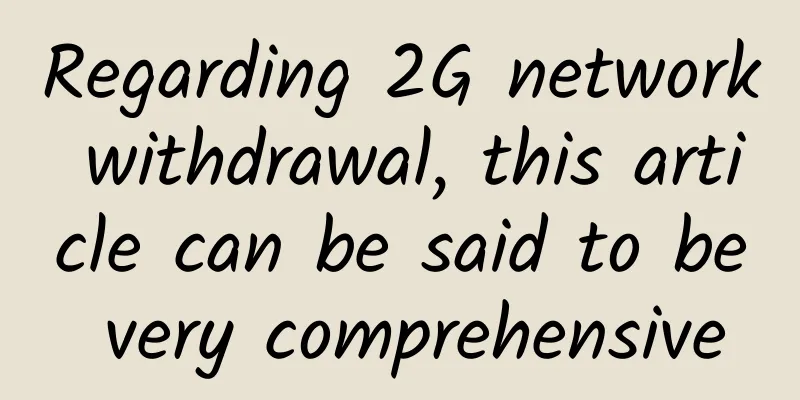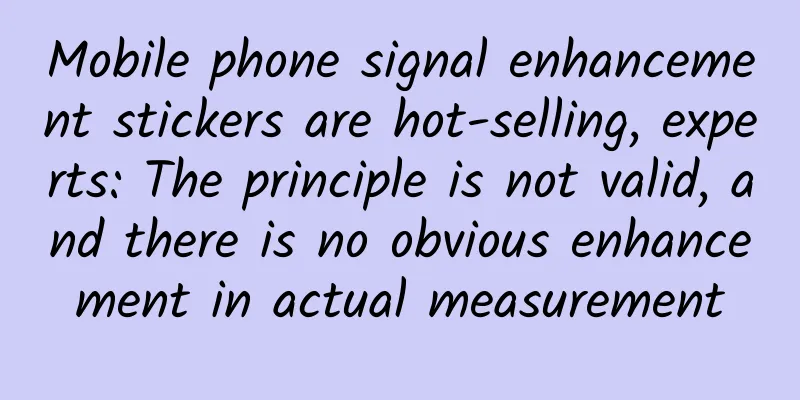Regarding 2G network withdrawal, this article can be said to be very comprehensive

|
The withdrawal of 2G network is actually not a new thing. In April 2016, US operator AT&T announced that it would phase out its 2G network by the end of that year, which was considered a preventive measure for everyone at the time. Over the years, the industry has been watching and waiting for news from China. Everyone’s focus is not on “will the refund be made?” but “who will refund first? How will the refund be made?” Now, the news is out - the first shot of domestic network withdrawal was fired by China Unicom. Again, this result was expected by most people. Regarding this matter, please allow me to start from the beginning. History of 2G development in China In the late 1990s, Europe developed GSM and the United States developed CDMA, which became the representatives of 2G technology standards. China was in the initial stage after the reform and opening up. After weighing and comparing, we chose GSM, which was more mainstream and mature at the time, as the direction of our network construction. In 1992, the former Ministry of Posts and Telecommunications approved the construction of a GSM trial network in Jiaxing, Zhejiang. On September 19, 1993, my country's first digital mobile phone communications network was launched in Jiaxing City, Zhejiang Province. From then on, 2G took root in China. In 1994, Wu Jichuan, former Minister of Posts and Telecommunications, was making a GSM call. China Mobile was founded in 2000. The network it operates is the GSM network inherited from the old Telecom. China Unicom has been using GSM since its establishment in 1994. Since China chose GSM in the beginning, it had no intention to build a CDMA network. However, things are unpredictable. When China was negotiating to join the WTO, the Americans insisted on using the CDMA network as a condition for China to build a network. There was no other choice but to build it. So, this task was given to China Unicom. In this way, China Unicom built a CDMA network (launched in January 2002) in addition to the existing GSM network. You ask me where is China Telecom? At that time, Telecom was torn into pieces, without a mobile communications license, and could only tinker with traditional fixed-line telephone and other businesses. Later, in 2008, after N rounds of splits and restructuring, China's telecom operators entered a new stage. China Telecom finally got the coveted mobile communications ticket. Of course, the ticket had to be paid for - as the buyer, China Telecom spent 110 billion RMB to buy CDMA from China Unicom. As a result, China Mobile operated GSM, China Unicom operated GSM, and China Telecom operated CDMA. At the same time, 3G licenses were officially issued, and China Mobile took up the banner of TD-SCDMA, the "domestic standard". Telecom, because it had a CDMA network, continued to use CDMA in 3G, which became CDMA2000. The happiest country was China Unicom, which obtained the world's best communication technology standard at that time - WCDMA, the legitimate successor to GSM. The pattern became like this: Later, in 2013, 4G licenses were issued. As we all know, China Mobile was the first to join the TD-LTE movement, while China Unicom and China Telecom started FDD-LTE. This eventually led to the current situation: The above is a brief history of the development of China’s mobile communication standards. It can be regarded as the background of the story. Why should we get rid of 2G? Actually, there is nothing wrong with this situation. Everyone is happy with it. You can make calls, send text messages, and surf the Internet with 4G speed. You can watch videos and play games without any problems. In this case, why go to the trouble of proposing to kill 2G? There are many reasons for this. By the way, 2G has been serving you tirelessly for more than 20 years, which is older than some readers are. . . Old technology means it is mature. If it still works and can make money, then there is nothing wrong with continuing to use it. However, 2G has been losing money for many years. Now is the 4G era, and most people are using 4G networks. There are actually not many users who are still using 2G. The 2G users usually refer to two categories:
This group of users is basically composed of elderly people who use feature phones, only make phone calls occasionally, and are very sensitive to costs. What is the exact number of 2G users? Let's take China Unicom as an example: Currently, China Unicom's 2G customers account for about 2% of the total number of customers, or about 5 million. For operators, these users do not bring much profit. However, it is obviously not cost-effective to maintain an extra network for these few users. At present, 2G equipment is seriously aging, with a high failure rate and increasing pressure on maintenance costs. Another point is that 2G equipment consumes a lot of energy, which makes operators even more painful. Based on the above reasons, operators are finally going to take action on 2G. Why is it so difficult to kill 2G? You may ask, if there are so many good reasons, why didn't the operators take action earlier, but waited until now? There are two reasons involved here. The first point is: turning off 2G will affect network coverage. Everyone who uses a mobile phone must have encountered such a situation—— When you enter a place with poor signal, such as an underground garage, the phone will automatically switch from 4G signal to 3G or 2G signal. At this time, the Internet speed will become very slow, and it will be difficult to open WeChat, but you can still make calls. Why is this happening? This is because 2G networks were built the earliest and used low-frequency bands, which means stronger coverage. In the 2G era, everyone used feature phones, which were mainly used for making calls and rarely surfing the Internet. In this situation, operators built networks based on coverage. The larger the coverage area, the fewer base stations were needed, and the more money was saved. Later, 3G and 4G gradually developed, and the frequencies they used generally moved towards high frequency bands. The high frequency band has abundant frequency resources, which is conducive to improving the rate. However, the coverage of the high frequency band is very poor - if the distance is far or there are some obstacles, there will be no signal. This is why there is no 4G signal in remote areas, but only 2G signal. However, everyone should understand that 2G has better coverage not because of its advanced technology, but because it occupies a high-quality frequency band. If 3G/4G uses that frequency band, it can also achieve high-quality coverage. If 2G is turned off and the 2G frequency is given to 3G or 4G, the problem of "reduced signal quality in remote areas" can be solved. Therefore, the decline in network coverage quality caused by shutting down the 2G network is only a transitional process and will not exist for a long time. The second reason why 2G has not been phased out of the network is the real problem - the problem of making phone calls. The most important function of a mobile phone is to make calls. As Xiaozaojun has introduced before, 4G LTE itself does not support phone calls, but only supports Internet access (i.e. data services). Theoretically, if you want to make calls using LTE, you must use VoLTE. (What is VoLTE? See here) Currently, due to the insufficient coverage of 4G networks, VoLTE has a poor experience and cannot replace traditional phones. As a transition, technologies such as CSFB or eSRVCC must be used, which means that calls can only be made by relying on 2G or 3G networks. If you rashly dismantle the 2G and 3G networks, you will most likely not be able to make any calls. This is the most fundamental reason why 2G, 3G and 4G networks currently coexist. How to withdraw from 2G network? In this case, how can we achieve "withdrawing from 2G network without affecting users"? This involves the operator's network withdrawal strategy. If the strategy is not appropriate, it is likely to affect the user experience, thereby affecting the number of users and affecting its own market competition. For the three major operators, their respective network exit strategies must be carefully considered. China Unicom was the first to take action because its situation was the most optimistic. For China Unicom, its 3G is WCDMA, which is a very good network standard with high maturity. Even without VoLTE, WCDMA can support mobile phone calls without disconnecting the network, so it can safely and boldly kill its own GSM network (2G). As long as it quickly gives up the 2G frequency to 3G/4G, the user experience will not be much different. Telecom's situation is more complicated. It has CDMA 2G and CDMA 3G, or more precisely, CDMA2000 1X and CDMA2000 Ev-Do. Ev-Do stands for Evolution - Data Only. It can only support data services, so it does not support phone calls. Telecom cannot directly withdraw its 2G network. Telecom's initial approach should be to reduce the number of carrier frequencies, retaining only a few 1X and DO carrier frequencies for 800M, and using the remaining LTE carrier frequencies. Therefore, I personally estimate that Telecom may withdraw 3G first, and then withdraw 2G when the low-frequency LTE achieves better coverage. China Mobile's 3G network is based on the TD-SCDMA standard. I have previously written an article (link) introducing that the quality of TD-SCDMA's network is very poor and basically useless. On the contrary, China Mobile's GSM network is more reliable and has very complete coverage. Therefore, China Mobile's approach should be to kill its own 3G first, retain 2G, and then continue to develop 4G. I feel sad to move for a second again... 2G network is withdrawn, what should users do? Finally, we still need to be concerned about the issue of "what should users do after the 2G network is shut down". In fact, as mentioned above, for most 3G/4G users, shutting down the 2G network will not affect their perception. The problem of the 5 million China Unicom pure 2G users will not be difficult to solve. On the one hand, China Unicom will migrate through packages with the same or similar tariff standards. On the other hand, it will also adopt methods such as subsidizing the purchase costs of mobile phones to guide old users to switch networks. It's just a little money anyway, which is nothing compared to the high cost of network maintenance. You know, when China Telecom retired its PHS service, it had nearly 100 million users, didn't it just retire? In addition to these 2G mobile phone users, there is another user group that needs attention - that is, users of the Internet of Things based on the GSM network, such as shared bicycles. Early shared bicycles used GSM cards, which did not require high network speeds but had high requirements for coverage. If 2G network is shut down, these IoT users will also be affected. This problem is not difficult to solve. Operators will definitely guide the direction of NB-IoT (Narrowband Internet of Things), which happens to be in line with the strategy of operators to vigorously develop NB-IoT. Okay, having said so much, let me summarize. 2G has made outstanding contributions to the development of the world's communication network, and its contribution is indispensable. However, in the era of 5G, it has become a heavy burden. If we do not decisively remove this burden, there will be no way to welcome 5G, let alone win the initiative in the 5G battle. So, please face the departure of 2G calmly. Its demise is the shining beginning of a new era! |
>>: Predictions for IT development after COVID-19
Recommend
Six ways 5G can save the global supply chain
5G enables real-time data at the point of origin,...
Megalayer: Dedicated servers from 299 yuan/month, optimized CN2 lines in mainland China, Hong Kong/Philippines/US VPS annual payment from 159 yuan
Megalayer is a subsidiary of Vofo, founded in 201...
Brocade Expands Data Center Networking Solutions to Accelerate Digital Transformation
Brocade today announced the expansion of the Broc...
What new entrepreneurial opportunities will 5G+AI and 5G+IoT generate?
What entrepreneurial opportunities are there in t...
Liu Pingyang of Youpaiyun: The whole industry releases the charm of CDN and the live broadcast market accelerates again
[51CTO.com original article] The interview with L...
Scenario Innovation Smart Energy | Ruijie Debuts at 2019 Petroleum and Petrochemical Information Technology Conference
From May 15th to 16th, the "2019 China Petro...
Google’s former CEO said that “the United States lags behind China in the 5G competition”, but don’t ignore the United States’ latecomer advantage!
Recently, former Google CEO Eric Schmidt and Harv...
Improve efficiency Essential tools on Mac
[[396744]] There are many useful software on Mac,...
Chinese Academy of Engineering Academician: 5G will consume 2.1% of national electricity consumption in 2026
On the afternoon of September 1st, at the "5...
Riverbed Launches Industry's Most Comprehensive Digital Experience Management Solution
Recently, Riverbed Technology announced the launc...
Schneider Electric is a pioneer in green data centers
With the rapid development of information technol...
Wi-Fi 7 is on the way, how powerful is it?
In 2019, Samsung and Apple were the first to intr...
WiFi is slow and stuck, maybe it’s a traffic jam
The NBA Finals are coming! But when using WiFi to...
Introduction and solution of TCP sticky packet and half packet (Part 1)
In network transmission, sticky packets and half ...
![[6.18] Eurasia Cloud: Los Angeles CN2 GIA line VPS quarterly payment starts from 56.8 yuan](/upload/images/67cabe93dbfe8.webp)








